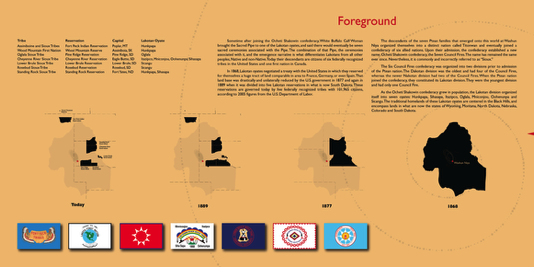Click the logo to go to the Lakota Emergence
homepage

Foreground
The descendants of the seven Ptean families that emerged onto this world at Washun Niya organized themselves into a distinct nation called Titonwan and eventually joined a confederacy of six allied nations. Upon their admission, the confederacy established a new name, Ocheti Shakowin confederacy, the Seven Council Fires. The name has remained the same ever since. Nevertheless, it is commonly and incorrectly referred to as “Sioux.”
The Six Council Fires confederacy was organized into two divisions prior to admission of the Ptean nation. The Dakotan division was the oldest and had four of the Council Fires, whereas the newer Nakotan division had two of the Council Fires. When the Ptean nation joined the confederacy, they constituted its Lakotan division. They were the youngest division and had only one Council Fire.
As the Ocheti Shakowin confederacy grew in population, the Lakotan division organized itself into seven oyates: Hunkpapa, Sihasapa, Itazipco, Oglala, Mniconjou, Oohenunpa and Sicangu. The traditional homelands of these Lakotan oyates are centered in the Black Hills, and encompass lands in what are now the states of Wyoming, Montana, North Dakota, Nebraska, Colorado and South Dakota.
Sometime after joining the Ocheti Shakowin confederacy, White Buffalo Calf Woman brought the Sacred Pipe to one of the Lakotan oyates, and said there would eventually be seven sacred ceremonies associated with the Pipe. The combination of that Pipe, the ceremonies associated with it, and the emergence narrative is what differentiates Lakotans from all other peoples, Native and non-Native. Today their descendants are citizens of six federally recognized tribes in the United States and one first nation in Canada.
In 1868, Lakotan oyates negotiated a treaty with the United States in which they reserved for themselves a huge tract of land comparable in area to France, Germany, or even Spain. That land base was drastically and unilaterally reduced by the U.S. government in 1877 and again in 1889 when it was divided into five Lakotan reservations in what is now South Dakota. These reservations are governed today by five federally recognized tribes with 101,965 citizens, according to 2005 figures from the U.S. Department of Labor.

